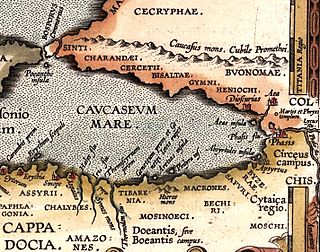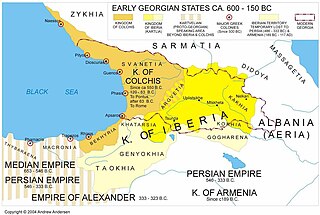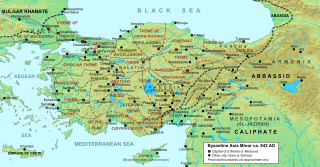
Xenophon of Athens was a Greek military leader, philosopher, and historian, born in Athens. At the age of 30, Xenophon was elected commander of one of the biggest Greek mercenary armies of the Achaemenid Empire, the Ten Thousand, that marched on and came close to capturing Babylon in 401 BC. As the military historian Theodore Ayrault Dodge wrote, "the centuries since have devised nothing to surpass the genius of this warrior". Xenophon established precedents for many logistical operations, and was among the first to describe strategic flanking maneuvers and feints in combat.

Cyrus the Younger was an Achaemenid prince and general. He ruled as satrap of Lydia and Ionia from 408 to 401 BC. Son of Darius II and Parysatis, he died in 401 BC in battle during a failed attempt to oust his elder brother, Artaxerxes II, from the Persian throne.

Anabasis is the most famous work of the Ancient Greek professional soldier and writer Xenophon. It gives an account of the expedition of the Ten Thousand, an army of Greek mercenaries hired by Cyrus the Younger to help him seize the throne of Persia from his brother, Artaxerxes II, in 401 BC.

A peltast was a type of light infantry originating in Thrace and Paeonia and named after the kind of shield he carried. Thucydides mentions the Thracian peltasts, while Xenophon in the Anabasis distinguishes the Thracian and Greek peltast troops.

Diauehi (Georgian დიაოხი, Urartian Diauehi, Greek Taochoi, Armenian Tayk, possibly Assyrian Daiaeni) was a tribal union located in northeastern Anatolia, that was recorded in Assyrian and Urartian sources during the Iron Age. It is usually (though not always) identified with the earlier Daiaeni(Dayaeni), attested in the Yonjalu inscription of the Assyrian king Tiglath-Pileser I's third year (1118 BC) and in later records by Shalmaneser III (845 BC). While it is unknown what language(s) they spoke, they may have been speakers of a Kartvelian, Armenian, or Hurrian language.

The Ten Thousand were a force of mercenary units, mainly Greeks, employed by Cyrus the Younger to attempt to wrest the throne of the Persian Empire from his brother, Artaxerxes II. Their march to the Battle of Cunaxa and back to Greece was recorded by Xenophon, one of their leaders, in his work Anabasis.

Corduene was an ancient historical region, located south of Lake Van, present-day eastern Turkey.

The Chalybes and Chaldoi were peoples mentioned by classical authors as living in Pontus and Cappadocia in northern Anatolia during Classical Antiquity. Their territory was known as Chaldia, extending from the Halys River to Pharnakeia and Trabzon in the east and as far south as eastern Anatolia. According to Apollonius of Rhodes, the Chalybes were Scythians.

The Macrones were an ancient Colchian tribe in the east of Pontus, about the Moschici Mountains. The name is allegedly derived from the name of Kromni valley by adding Kartvelian ma- prefix which denotes regional descendance.

The Tibareni were a people residing on the coast of ancient Pontus referred to in Herodotus, Xenophon, Strabo and other classical authors. The Tibareni were believed to be of proto-Kartvelian or Scythian origin.
Meno, son of Alexidemus, was an ancient Thessalian political figure. Probably from Pharsalus, he is famous both for the eponymous dialogue written by Plato and his role as one of the generals leading different contingents of Greek mercenaries in Xenophon's Anabasis.
Ariaeus was a Persian general who fought alongside Cyrus the Younger at the Battle of Cunaxa and later was involved in the assassination of Tissaphernes.

Chaldia was a historical region located in the mountainous interior of the eastern Black Sea, northeast Anatolia. Its name was derived from a people called the Chaldoi that inhabited the region in antiquity. Chaldia was used throughout the Byzantine period and was established as a formal theme, known as the Theme of Chaldia, by 840. During the Late Middle Ages, it formed the core of the Empire of Trebizond until its fall to the Ottoman Empire in 1461.
Gambrium or Gambrion, also Gambreium or Gambreion (Γάμβρειον), was a town of ancient Aeolis and of Mysia, quite close to Pergamum. Its location is near Kınık and Bergama in İzmir province, in the Aegean Region of Turkey.

The Abasgoi or Abasgians were one of the ancient tribes inhabiting western region of Abkhazia, who originally inhabited lands north of Apsilae, corresponding to today's Ochamchira District. In 550, during the Lazic War, the Abasgians revolted against the Eastern Roman (Byzantine) Empire and called upon Sasanian assistance. General Bessas however suppressed the Abasgian revolt.

The Sanigs were a tribe inhabiting Western Georgian/Abkhazia during antiquity. Their ethnic identity is obscure and is the subject of a controversy. They are first attested in the works of Pliny, Arrian and Memnon of Heraclea. Some scholars consider them to be Zans, while others maintain that they were proto-Svans. There is also a consideration that they may have been somewhat similar to the Zygii tribe. According to Arrian, they inhabited the area around Sebastopolis. In favour of the Sanigs' Kartvelian origin, it is important to mention some modern Georgian surnames such as: Sanikidze, Sanikiani, Sanigiani, Sanaia.
The Sanni are mentioned by Strabo, Pliny the Elder and Arrian as a people settling near Trebizond. In the 1st and 2nd centuries AD, their territory extended to the north-east until the river Ophis, and covered both the littoral and the mountainous hinterland. Pliny grouped together the Sanni who lived in the region of Trebizond and the Heniochi as one single nation. He also mentions other Sanni, living further on the Colchis littoral, past the mouth of the Rioni.
Cossaei (Κοσσαῖοι) were a warlike tribe inhabiting a mountainous district called Cossaea (Κοσσαία), likely related to the Kassites, on the borders of Susiana to the south, and of Media Magna to the north. They were a hill tribe, and were armed with bows and arrows. Their land was sterile and unproductive, and they lived the life of robbers. Strabo speaks of them as constantly at war with their neighbours, and testifies to their power when he says that they sent 13,000 men to assist the Elymaei in a war against the people of Babylonia and Susiana. Alexander led his forces against them and subdued them, at least for a time. The Persian kings had never been able to reduce them, but had been in the habit of paying them a tribute, when they moved their court annually from Ecbatana to Babylon, to pass their winter at the latter place. In character, they seem to have resembled the Bakhtiari tribes, who now roam over the same mountains which they formerly occupied.
Salmydessus or Salmydessos, also Halmydessus or Halmydissos (Ἁλμυδισσός), was a coast-town of ancient Thrace, on the Euxine, about 97 kilometres (60 mi) northwest of the entrance of the Bosporus. The eastern offshoots of the Haemus here come very close to the shore, which they divide from the valley of the Hebrus. The people of Salmydessus were thus cut off from communication with the less barbarous portions of Thrace, and became notorious for their savage and inhuman character, which harmonised well with that of their country, the coast of which was extremely dangerous. Aeschylus, who incorrectly places the town in Asia Minor, describes Salmydessus as "the rugged jaw of the sea, hostile to sailors, step-mother of ships;" and Xenophon informs us, that in his time its people carried on the business of wreckers in a very systematic manner, the coast being marked out into portions by means of posts erected along it, and those to whom each portion was assigned having the exclusive right to plunder all vessels and persons cast upon it. This plan, he says, was adopted to prevent the bloodshed which had frequently been occasioned among themselves by their previous practice of indiscriminate plunder. Strabo describes this portion of the coast of the Euxine as "desert, rocky, destitute of harbours, and completely exposed to the north winds;" while Xenophon characterises the sea adjoining it as "full of shoals." The earlier writers appear to speak of Salmydessus as a district only, but in later authors, as Apollodorus, Pliny the Elder, and Pomponius Mela, it is mentioned as a town.
Rathines - the leader of the Cadusii and general of Pharnabazus III.











